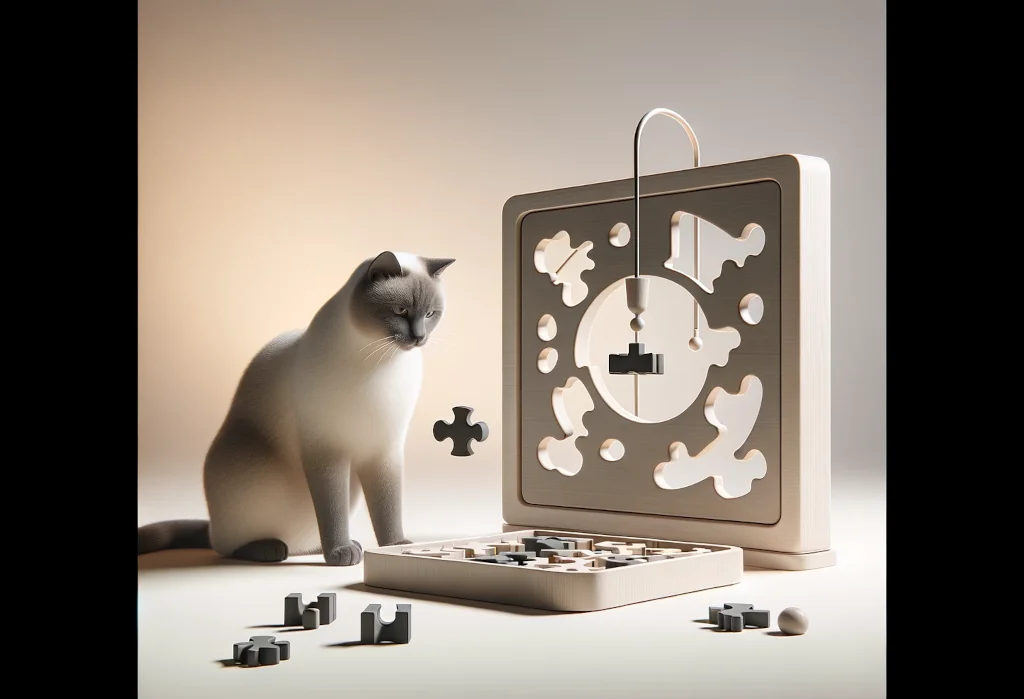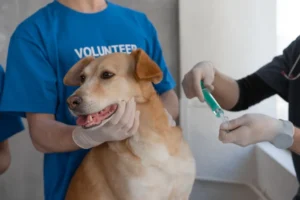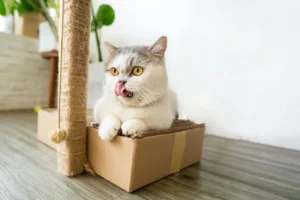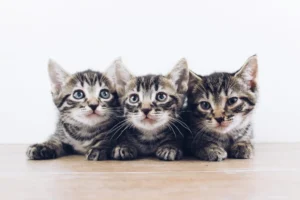Ever watched your cat chase its own shadow and thought, “Genius at work”? Yeah, us too. But what if we told you there’s a way to actually up their smart cat creds and keep them entertained? This post promises to take you through the why and the how puzzle feeders and interactive toys not only add fun to your furry friend’s daily routine but also serve as vital cognitive enhancers.
Key takeaways:
- Puzzle feeders and interactive toys mimic natural hunting activities, sharpening your cat’s problem-solving skills and physical agility.
- Regular play with these cognitive boosters can prevent boredom-induced behaviors by keeping your cat’s mind engaged and body active.
- Adjusting the difficulty levels of puzzle feeders can continuously challenge and promote your cat’s cognitive growth over time.
How Do Puzzle Feeders Stimulate Your Cat’s Brain?
Ever watched your cat meticulously work at a puzzle feeder, their focus unwavering as they attempt to snag their tasty reward? It’s not just an entertaining sight; it’s a brain workout for your feline friend.
Puzzle feeders demand that cats use their senses and problem-solving skills, closely mimicking the mental gymnastics they’d perform while hunting outdoors. This type of stimulation is crucial, engaging their natural instincts and preventing the boredom that indoor life can sometimes bring.
A well-designed puzzle feeder encourages your cat to think creatively. For example, they might need to figure out how to move pieces around to access food or understand that certain actions will yield tasty results. This process improves their cognitive functions by challenging them to solve problems, improving their memory, and keeping their minds sharp and alert.
lus, achieving a goal (like getting to the food) floods their little brains with dopamine, the feel-good neurotransmitter, enhancing their mood and overall well-being.
Unique Tip: Opt for a puzzle feeder that can be adjusted in difficulty levels. Start easy to pique your cat’s interest, then gradually increase the challenge as they become more adept. This way, the feeder remains stimulating even as your cat’s problem-solving skills improve.
Why Should Your Cat Play with Interactive Toys?
Interactive toys are more than just playthings; they are essential tools that stimulate your cat’s predatory instincts. These toys mimic the unpredictable movements of prey, encouraging your cat to stalk, pounce, and capture, just as they would in the wild. This not only keeps them physically fit but also sharpens their mental acuity.
Engaging with interactive toys provides a healthy outlet for your cat’s natural hunting instincts. Indoor cats, in particular, benefit greatly from these toys as they substitute for the hunting experiences they miss out on. For example, a simple laser toy that casts a bright dot on the floor mimics the erratic movements of a small insect or rodent, providing endless entertainment and mental stimulation for your cat.
The benefits of such play are multi-fold: it improves coordination, builds muscle tone, and reduces stress and anxiety. Engaging your cat in daily play sessions with interactive toys can significantly enhance their quality of life, keeping them both happy and healthy.
What Are the Signs Your Cat Needs More Mental Stimulation?
Cats are adept at hiding their feelings, but certain behaviors can signal that your kitty is climbing the walls with boredom. Here are some tell-tale signs your cat might be craving more mental stimulation:
- Lethargy or Lack of Interest: A cat with too much time on their paws may sleep more than usual or show little interest in their surroundings. This can be mistaken for laziness, but it might be a cry for more engaging activities.
- Excessive Grooming: When bored, some cats turn to overgrooming, which can lead to bald patches or skin infections. It’s their way of self-soothing.
- Aggression: This could manifest as unprovoked attacks on other pets or even you. It’s a misdirected expression of their hunting instincts.
- Mischievous Behavior: Whether it’s knocking items off the shelf or unrolling the toilet paper, these antics could be your cat’s attempt at self-entertainment.
In response to these behaviors, introducing puzzle feeders and interactive toys can make a world of difference. It gives your cat a constructive outlet for their energy and curiosity, significantly reducing undesirable behaviors. Remember, a mentally stimulated cat is a content cat.
Incorporating these cognitive boosters into your cat’s daily routine can transform their health and happiness. Keep an eye out for the signs of boredom and be ready to spice up their playtime with engaging and challenging toys that satisfy their natural instincts and keep their minds sharp. Remember, your active involvement in playtime sessions not only strengthens the emotional bond with your pet but also enhances the stimulation they receive, making every game an opportunity for learning and growth.
How to Choose the Right Puzzle Feeder or Interactive Toy for Your Cat?
When it’s time to pick a puzzle feeder or interactive toy for your feline friend, the sea of options can be overwhelming. It’s like trying to choose the most tantalizing treat from a gourmet pet store – where do you even start? Fear not, because we’re about to break it down for you, making the selection process as easy as pie.
Firstly, consider your cat’s age and agility. Younger cats and kittens usually have more energy to burn, so they might be more inclined towards toys that require a lot of physical activity, like chasing or jumping. For these energetic furballs, look for toys that move unpredictably or allow them to engage in a hunt-like play. On the other hand, senior cats might appreciate simpler puzzles that don’t require as much physical effort but still keep their minds sharp.
Next up is assessing their interest level. Some cats are naturally more curious and driven by food, making them perfect candidates for feeder puzzles that challenge them to think outside the box to get their treats. Others might be more playful or driven by texture and sound, so toys that crinkle, light up, or dispense treats upon interaction might be more up their alley.
Here’s a little secret sauce most people don’t think about: trial and error is your best friend. Every cat is unique, and their preferences can change over time. Don’t be afraid to test out a few different toys and see what captivates your cat’s interest the most.
Specific Tips :
– For a high-energy kitten: Try a laser pointer game or an electronic mouse that zips around, stimulating their chase instinct.
– For an older, less active cat: Opt for a puzzle feeder that encourages them to solve a problem to access food, combining mental stimulation with a tasty reward.
Can Puzzle Feeders and Interactive Toys Help with Weight Management?
Absolutely, yes! Puzzle feeders and interactive toys are not just fun and games; they play a pivotal role in managing your cat’s weight. Engaging your furball in active play and mindful eating can significantly contribute to their overall health. Let’s dive into how these ingenious tools can be a cornerstone of a weight management plan.
Promoting Active Play
Cats are natural hunters. In the wild, they’d spend a considerable part of their day stalking and capturing prey, which keeps them fit. In the cozy confines of your home, puzzle toys and feeders can mimic these conditions, encouraging your cat to move more. By incorporating these forms of play, you’re essentially tricking them into exercising – and they enjoy every moment of it! This increase in physical activity naturally helps in burning off excess calories.
Portion Control
Ever noticed how some cats can be a little… greedy with their food? It’s nothing to be ashamed of – we all love a good buffet. However, when it comes to managing weight, portion control is crucial. Puzzle feeders come to the rescue here by making your cat work for their food. This can slow down their eating pace, reduce overeating, and make mealtime last longer, which aids in digestion and helps in maintaining a healthy weight.
A Unique Tip
Now, for a slice of unique advice that you might not find on the typical pet blog. Consider integrating vertical space with your cat’s play and feeding routine. Vertical feeders or toys that can be placed at varying heights encourage jumping and climbing, utilizing those often overlooked muscles and adding an extra layer of challenge to their day.
This not only spices up their playtime but aids significantly in weight management. Setting up a simple shelf where your cat has to jump up to reach their puzzle feeder can make a world of difference.
In Conclusion
Puzzle feeders and interactive toys are about more than just keeping your feline friend occupied. They’re a multifaceted tool that can enrich your cat’s life in numerous ways, from boosting their cognitive abilities to keeping their waistline in check. With the tips and insights shared, you’re now equipped to make informed decisions that will benefit your cat’s health and happiness. Remember, a stimulated cat is a happy cat – and your puzzle feeder or toy might just become their new best friend. So, here’s to a future of fun, engaging play that keeps your kitty both mentally sharp and physically fit!
Alex, a passionate animal lover, has experience in training and understanding animal behavior. As a proud pet parent to two dogs and three cats, he founded AnimalReport.net to share insights from animal experts and expand his knowledge of the animal kingdom.










